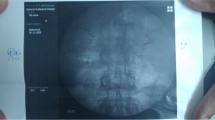Abstract
The objective of this study was to assess the accuracy of blind placement of caudal epidural needles and the usefulness of the radio-contrast epidurogram. The study involves a prospective case series of 147 consecutive patients with radiological assessment of blind needle placement and epidurogram assessing the accuracy of blind needle placement in caudal epidurals. When the surgical miss rate (26%) and failure of flow of the therapeutic agents (6%) are combined, it can be deduced that up to 32% of non-radiologically guided caudal epidurals may fail to deliver the therapeutic agents to the site of pathology. There was no significant difference in the accuracy of needle placement in adequately trained and experienced middle grade surgeons when compared with consultant surgeons performing these procedures regularly. In conclusion, we recommend radiological guidance and use of epidurogram as the gold standard for the administration of caudal epidurals to increase the likelihood of successful delivery of the therapeutic agents to the site of pathology during the procedure.

Similar content being viewed by others
References
Abdi S, Datta S, Trescot A et al (2007) Epidural steroids in the management of chronic spinal pain: a systematic review. Pain Physician 10:185–212
The British Society for Rheumatology. Guidelines on Epidural Steroids in Spinal Pain. http://www.rheumatology.org.uk/includes/documents/cm_docs/2009/e/epidural_steroids_for_spinal_pain.pdf
Price C, Rogers P, Prosser A, Arden N (2000) Comparison of the caudal and lumbar approaches to the epidural space. Ann Rheum Dis 59:879–882
White AH, Derby R, Wynne G (1980) Epidural injections for the diagnosis and treatment of low back pain. Spine 5:78–86
Stitz M, Sommer H (1999) Accuracy of blind versus fluoroscopically guided epidural injection. Spine 24(13):1371–1376
Manchikanti L, Cash K, Pampati V, McManus C, Damron K (2004) Evaluation of fluoroscopically guided caudal epidural injections. Pain Physician 7(2):81–92
Renfrew D, Moore T, Kathol M, el-Khoury G, Lemke J, Walker C (1991) Correct placement of epidural steroid injections: fluoroscopic guidance and contrast administration. Am J Neuroradiol 12:1003–1007
Senoglu N, Senoglu M, Oksuz H et al (2005) Landmarks of the sacral hiatus for caudal epidural block: an anatomical study. Br J Anaesth 95(5):692–695
Sekiguchi M, Yabuki S, Satoh K, Kikuchi S (2004) An anatomic study of the sacral hiatus: a basis for successful caudal epidural block. Clin J Pain 20(1):51–54
General Medical Council Guidance on Consent. Patients and doctors making decisions together Part 2: making decisions about investigations and treatment. http://www.gmc-uk.org/guidance/ethical_guidance/consent_guidance/discussing_side_effects_complications_and_other_risks.asp
Royal College of Anaesthetists and The Pain Society. Recommendations on the use of epidural injections of back pain and leg pain of spin al origin. Royal College of Anaesthetists July 2002 Bulletin 14. http://www.britishpainsociety.org/epi_inj.pdf
Manchikanti L, Bakhit C, Pampati V (1998) The role of epidurography in caudal neuroplasty. Pain Digest 8:277–281
Chen C, Tang S, Hsu T et al (2004) Ultrasound guidance in epidural needle placement. Anaesthesiology 101:181–184
Schwartz D, Raghunathan K, Dunn S, Conelly NR (2008) Ultrasonography and paediatric caudals. Anesth Analg 106:97–99
Lewis M, Thomas P, Wilson L, Mulholland R (1992) The “Whoosh” test. A clinical test to confirm correct needle placement in caudal epidural injections. Anaesthesia 47:57–58
Eastwood D, Williams C, Buchan I (1998) Caudal epidurals: the whoosh test. Anaesthesia 53:305–307
Saberski L, Kondamuri S, Osinubi O (1997) Identification of the epidural space: is loss of resistance to air a safe technique? A review of the complications related to the use of air. Reg Anaesth 22(1):3–15
Author information
Authors and Affiliations
Corresponding author
Rights and permissions
About this article
Cite this article
Barham, G., Hilton, A. Caudal epidurals: the accuracy of blind needle placement and the value of a confirmatory epidurogram. Eur Spine J 19, 1479–1483 (2010). https://doi.org/10.1007/s00586-010-1469-8
Received:
Revised:
Accepted:
Published:
Issue Date:
DOI: https://doi.org/10.1007/s00586-010-1469-8




